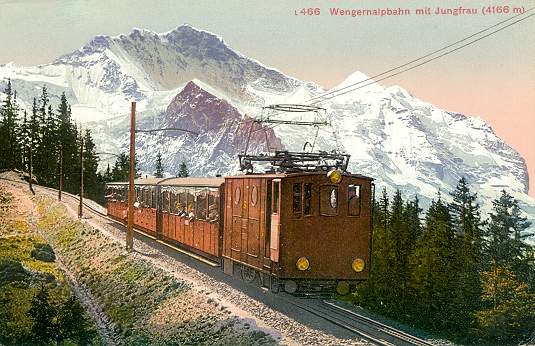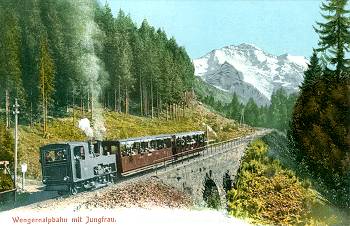

In the heart of the Bernese Oberland in Switzerland we find the Wengernalpbahn (WAB), the largest continuous rack railway system in the world. This postcard shows WAB electric locomotive 51 with a train at Bannwald with the Jungfrau in the background, which as the caption tells us is 4166 metres high. The card was published around 1910 by Photoglob of Zürich, a company that still produces postcards. The smaller view below, from a card by R.Gabler of Interlaken, dates from around 1905 and shows a train worked by steam at the location that is now called Allmend. The brown colour on these cards is fictitious as the livery was always a Brunswick green, later green and cream, but today the newer trains are yellow with green stripes.
When in 1890 the partial rack metre gauge Berner Oberland-Bahnen (BOB) opened from Interlaken to Lauterbrunnen with a branch from Zweilütschinen to Grindelwald, thoughts were given to a railway over the Kleine Scheidegg. A line was built to 800mm gauge and used the Pauli-Riggenbach rack system, a lighter version of that designed by Niklaus Riggenbach and used on the BOB. On 18th April 1892 the first test train ran from Lauterbrunnen to Wengen. On 20th June 1893 the full system opened. During 1909 and 1910 the system was electrified at 1500 volts DC and new electric locomotives were introduced, although steam locos continued to run occasionally with the last steam worked trains being used in 1917. On 7th July 1910 the "new line" was opened between Witimatte (just outside Lauterbrunnen) via Wengwald to Wengen, this being slightly longer and using several tunnels to provide a less steep and thus faster route. The old line was retained for slower goods trains but in recent years with the introduction of faster goods locomotives it has been little used, so the track was lifted in the summer of 2009.
The 19.2 km railway is worked in two halves, Lauterbrunnen to Kleine Scheidegg and Grindelwald to Kleine Scheidegg. This is so that, in common with most mountain railways, the locomotive (or motor unit) is always at the downhill end and pushes the carriages. There is no through running at Kleine Scheidegg although there is a triangular junction, partly in tunnel under the Lauberhorn, to enable units to be turned and exchanged between the two sections. Commencing in Lauterbrunnen (where there is a main depot and workshops) at a station shared with the BOB and opposite the bottom station for the cable car to Grütschalp for Mürren (see Postcard), it ascends the "new line" through Wengwald, a request stop, to Wengen where there is a smaller depot. Wengen is a traffic free village, so this lower section of the railway is heavily used and some trains terminate there. From Wengen the line climbs again, passing the request stop at Allmend and on to Wengernalp and then to Kleine Scheidegg, terminating at a station shared with the Jungfraubahn (JB) for trains to the Jungfraujoch. From Grindelwald at a station shared with the other branch of the BOB, the train descends to Grund where it reverses direction. There is a depot at Grund. The line then ascends via the request stop at Brandegg to Alpiglen and then on to Kleine Scheidegg. The system has additional request stops which have varied over the years and are seasonal.
The railway was summer only until 1909 when a winter service was run to Wengen. For the winter of 1910/11, largely at the request of British tourists, five trains ran daily from Wengen to Ausweichstelle (now named Allmend) for winter sports and in the following year three of them continued to Wasserstation and the next year to Wengernalp. From 1913/1914 the winter sports service ran from Wengen to Kleine Scheidegg. From 1912/13 winter trains started from Grindelwald to Brandegg, and from 1920/21 to Alpiglen, 1926 to Strättli and 1930 to a halt at Arvengarten (above Salzegg). The full winter service was not extended to Kleine Scheidegg until 1933/34. The winter sports services did not run during the period of the Great War when tourism was minimal. An interesting feature of the line is that in the winter small open goods trucks fitted with racks are attached to the front of trains to carry skis and toboggans. The operation of winter trains revolutionized the concept of skiing. Prior to this date those who wanted to ski had to be fit sportsman and first had to climb uphill. Wengen's trains virtually created the idea of a leisure skiing holiday and "downhill only" as Wengen's ski club is called.
 The steam service was operated by 16 locomotives of slightly differing designs but all built by Schweizerische Lokomotiv und Maschinenfabrik (SLM) of Winterthur between 1891 and 1906. The one in our view (left) is of the batch numbered 9 to 12 delivered in 1895/96. Steam loco number 1 was sold to the Brienz-Rothorn-Bahn in 1911 and still operates there. Number 51 in our main postcard was the first electric loco delivered to the WAB for steam replacement, being built by SLM in 1909 and having electrical equipment from Electricitätsgesellschaft Alioth of Münchenstein. It was one from a batch of eight built in 1909/10, with five similar locos supplied in 1911/12 and two slightly more powerful ones in 1926 and 1929 having electrical equipment from AG Brown Boveri & Cie (BBC) of Baden and Maschinenfabrik Oerlikon respectively. The open sided summer carriages seen in both postcards are of a general type supplied by Von Roll of Bern during steam days.
The steam service was operated by 16 locomotives of slightly differing designs but all built by Schweizerische Lokomotiv und Maschinenfabrik (SLM) of Winterthur between 1891 and 1906. The one in our view (left) is of the batch numbered 9 to 12 delivered in 1895/96. Steam loco number 1 was sold to the Brienz-Rothorn-Bahn in 1911 and still operates there. Number 51 in our main postcard was the first electric loco delivered to the WAB for steam replacement, being built by SLM in 1909 and having electrical equipment from Electricitätsgesellschaft Alioth of Münchenstein. It was one from a batch of eight built in 1909/10, with five similar locos supplied in 1911/12 and two slightly more powerful ones in 1926 and 1929 having electrical equipment from AG Brown Boveri & Cie (BBC) of Baden and Maschinenfabrik Oerlikon respectively. The open sided summer carriages seen in both postcards are of a general type supplied by Von Roll of Bern during steam days.
From 1947 the electric locomotives were phased out and replaced by a series of eighteen railcars from SLM with electrical equipment from BBC the last of which was delivered in 1964, with a further six similar cars added in 1970. These motor cars push control-trailers and most are still in service, although mainly used on the "extras" in winter. Subsequently four two-section articulated cars were bought in 1988 and four three-section low-floor cars with panoramic centre sections in 2004. Of the original electric locomotives, six were retained for goods traffic while nine were transferred together with some carriages to the nearby summer-only Schynige Platte Bahn (SPB) where most are still in use. During the 1980s some of this SPB stock was occasionally loaned back to the WAB to supplement the winter ski services, but then the arrival of the new vehicles has made this unnecessary. The goods service is quite extensive, especially in supplying traffic-free Wengen. Two new goods locos were added to the fleet in 1995.
 The mountain scenery viewed from the Wengernalpbahn is as stunning now as it was at the date of these postcards, and a visit to the railways in this region is highly recommended.
The mountain scenery viewed from the Wengernalpbahn is as stunning now as it was at the date of these postcards, and a visit to the railways in this region is highly recommended.
![]() After this postcard do you fancy a Swiss fondue? Then try the Fond-U-Like fondue website.
After this postcard do you fancy a Swiss fondue? Then try the Fond-U-Like fondue website.
![]() Go to Postcard Of The Month Index
Go to Postcard Of The Month Index